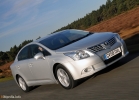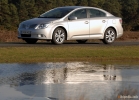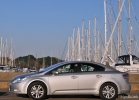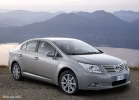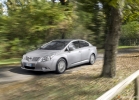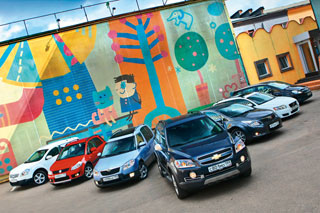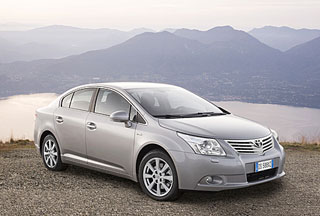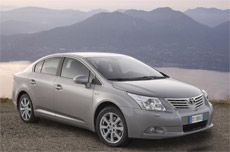Toyota Avensis test drive since 2009 sedan
Third Avensis
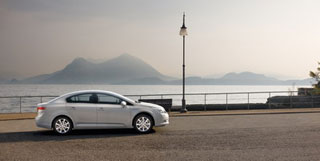 And he is the flagship because Camry is not for sale in Europe. But we are sold, and, moreover, it is produced. Therefore, the only question that I did not find an exhaustive answer during the first test drive Avensis in Italy as the company will breed two models in the Russian market. Especially in price: Camry will probably be cheaper than some versions of Avensis. However, waiting for the announcement of prices does not remain long, the novelty will debut in Russia, most likely in April. And besides, this, if you figure it out, are completely different cars, and everyone will probably have their own circle of fans. And the fact that the third -generation Avensis is quite capable of collecting its circle, I was quite convinced.
And he is the flagship because Camry is not for sale in Europe. But we are sold, and, moreover, it is produced. Therefore, the only question that I did not find an exhaustive answer during the first test drive Avensis in Italy as the company will breed two models in the Russian market. Especially in price: Camry will probably be cheaper than some versions of Avensis. However, waiting for the announcement of prices does not remain long, the novelty will debut in Russia, most likely in April. And besides, this, if you figure it out, are completely different cars, and everyone will probably have their own circle of fans. And the fact that the third -generation Avensis is quite capable of collecting its circle, I was quite convinced. Born in Nice
This model began to be produced at the Toyota plant in the UK, and they were hidden under the European taste in Nice, where the Japanese concern is located. The stay of designers on the azure bank went to Avensis clearly for the benefit: he retained external calm and dignity, but at the same time, he began to look more dynamic and presentable. Although in my personal taste the master slightly overdid the front: it turned out to be expressive, there are no words, but as if overloaded with original solutions. The grate pressed inside with the front bumper, unusual to the eye to the eye separates it from front lights spreading through the wings and hood. Stylistically, all this is somewhat reminiscent of the latest Lexus models. Perhaps for the better.
But in the profile and behind, the new Avensis looks very good. Both a sedan and a station wagon. And there will be no other options. Correct and clear lines are quite logical, and the decent dimensions of the optics with a thought -out pattern make the stern elegant. By the way, the station wagon was developed separately from the sedan, which is why it turned out, for my taste, even more dynamic. The same line of windows, a roof slightly dropping to the stern and a spoiler on the trunk lid. But both cars in the profile, oddly enough, evoke the idea of \u200b\u200ba single crew. The reason in the hood slightly extended forward, slightly tilted back by the central and rear stands, as well as in the raised front part, which smoothly passes into the cabin and a window line directed up, and then into the high trunk. In fact, the resulting form is unique, and it was in the best way affected aerodynamics: the frontal resistance coefficient of the sedan 0.28, the station wagon 0.29. By the way, the new Avensis is only 50 mm longer than the previous generation model: the length of the sedan is 4695 mm, the station wagon 4765 mm, with the same wheelbase of 2700 mm and the same height in the predecessor. At the same time, the platform itself is new. The front track increased by 45 mm, the back is 30 mm, the car became 50 mm wider. Hence the changed proportions and solidity in the form. And without increasing weight, which is important.
Since the former Avensis was the first D-class car awarded 5 stars at the EURONCAP crash tests for a record 34 points, the creators of the new generation also worked in this direction. In addition to the advanced body frame and its deformation zones, already in the Avensis database it is equipped with seven airbags, including a pillow for protecting the driver’s knees, active head restraints and, in accordance with new European standards, injuries (for pedestrians in case of collision) with a hood. I'm not talking about the presence of ABS, brake force distribution systems (EBD), Brake Assist and other electronic systems.
Separately, it is worth saying about the VSC+target stability system. It also makes a considerable contribution to active security, since now it also affects the steering electrical power. Fortunately, the gear ratio does not change, but only an additional torque is created, as a result of which, with sharp changes in the direction or speed, an effort is formed, as if prompting it to turn it. In truth, in fact, I did not particularly feel the work of this whole system, and is inclined to attribute this to the positive qualities of the car. Since electronics still does not interfere too much in the management process, and does not deprive the driver of pleasure from driving and a sense of control over the machine.
Material space
Do you know what I did not like the most in my predecessor? Two things: highly installed front seats and not too high -quality finishing materials. Naturally, climbing behind the wheel, I immediately drew attention to this, and inhaled with relief. In the interior, style and quality are immediately felt.
To begin with, the salon has become more spacious. Its volume is increased not only due to the grown body dimensions, but also due to the displacement of the front racks 110 mm forward, and the rear are 50 mm back. Hence the freedom in the shoulders and more space behind. But most importantly, the front seats became closer to the floor. That is, if earlier, even in the lowest position of the driver’s chair with the proper landing from my crown to the roof, five centimeters remained, now this distance has doubled twice. And the seat itself is much more convenient, with a successful back profile and normal lateral support. Of course, it is equipped with all the necessary adjustments, and within a very wide range. Sitting in front do not push the elbows (if they are not a sumo fighters), and the armrest between the seats is wide enough and successfully located. The steering column is adjustable both in height and by departure, and the steering wheel itself pleases the thickness of the rim and the central hub of the same trapezoidal form as the central console.
In the top version of the luxury, namely, these were proposed for the first acquaintance, the main place on the console is assigned to a large color monitor, and this is both an on-board computer, an audio system, and a full navigation. And another indicator of the level of slot for a CD on the panel is not. It is located in the same place where the SD -type slot (luxury versions also have a built -in hard drive for 10 GB), that is, behind the display, which will politely drive, it is worth clicking on the corresponding button. In general, the control interface of all functions is understandable, despite the abundance of buttons on both sides of the touch monitor. Under it, in the area of \u200b\u200bdirect reach for the driver and front passenger, a separate climate control unit, which, alas, is not installed in the base.
However, all the features of the equipment for our market are better to clarify with the official dealer, but I will note that inside the new Avensis it is quite comfortable. All controls are at hand, and even heating the seats is not just a button, but the belief and that right on the central console, lower than climate control. The instrument shield is quite traditional, but also not without a delight: two screens are located between the dials of the tachometer and the speedometer. The first, from below, informs about the temperature of the power unit, fuel and time. The second, slightly larger, displays the menu of the on -board computer with the usual set of functions: odometer, distance to refueling, medium and moment fuel consumption, etc.
But still, the most pleasant in the interior is a calm, verified design and high quality of finishing materials. So, the front panel can be executed in black, or in a combination of gray and beige colors, but the plastic in any case will be soft. The central console is slightly elevated above the panel and highlighted by one of several decor options: black metallic, trim under the titanium or very original with rough texture, an inspiration source when creating that was Japanese charcoal from bamboo. It was this option that I personally liked the most.
Inside, this should say enough space for small luggage, the rear seats fold both in the station wagon and in the sedan. Moreover, they form a flat floor. In the trunk of the station wagon, there are slides for fastening the cargo or dividing the compartment into the zones with additional partitions or nets. The volume of the trunk of the sedan is 509 liters, and the station wagon boasts 543 liters, which turn into 1609 with folded rear seats.
A little about the technique
The new Avensis will debut with the Toyota Optimal Drive concept. It is a whole range of new technologies used in creating engines and gearboxes, which, ultimately, reduce the friction of parts, make the engine’s design easier and more compact, increase the performance of the combustion process.
One of the key components of the concept is the use of new Valvematic gasoline engines that reduce CO2 emissions by 10-26% (depending on the transmission), and at the same time increase the power by 3-20%. In fact, Valvematic is the latest Toyota development in the field of gas distribution phases technology. The system controls not only the change in phases, but also the height of lifting the intake valves, as efficiently controlling the stream of absorbed air. Thus, the high performance of the combustion process is achieved and, therefore, an increase in power with a reduced fuel consumption.
Since in the engine with the Valvematic system the volume of fuel mixture supplied to the cylinders depends on the height of the valves, the traditional throttle began to perform other functions. Since there is no particular need to dose the amount of air using the damper, it is now almost always completely open with the engine running, and the maximum volume of air enters the intake manifold. Which, in turn, increases the acceptance of the engine, as the delay in feeding is eliminated.
However, it is time to check all this in the case, on the example of a version with a gasoline 2.0-liter engine.
European manners
The engine develops 152 hp, which is only 5 forces more than in the 1.8-liter power unit next in the engine in engine gamut. In general, there are no complaints about the dynamics of this version. The start of the place and acceleration is quite confident, assertive, and due to the fact that the 2.0-liter engine is aggregated exclusively with the Multidrive S variator, it occurs without pauses for gear shifts smoothly but quite intensively. With uniform movement, the variator itself will change the transfer number to minimize fuel consumption. But if you press the accelerator again, for example, for quick overtaking, then the fleeting thought of the transmission becomes noticeable. In any case, the motor is elastic and burden in almost the entire revolution range. For those who want to ride faster, Multidrive S offers a sports regime, or the opportunity to manually switch the pseudo program, of which seven were made. To do this, you can wield a lever itself, or use the keys on the back of the lamb. True, to be honest, you do not get much pleasure from driving on the verge in the new Avensis.
Firstly, because at high speeds the sound of a power unit penetrates the salon. Although the soundproofing of the car is simply excellent, because this was paid to special attention. Secondly, the machine lacks youth excitement. Despite the fact that Avensis chief engineer Takashi Yamamoto drove 5000 km, visited ten European countries to evaluate the needs and requests of local motorists, and then invited 35 engineers from the European headquarters to Japan and combined their efforts with the Japanese team, achieve the same The dynamics of movement they failed to the end. They sought to make manageability just gambling, and it is felt. But not so clearly as to put the model in a row, say, with Mazda6 or Honda Accord.
Yes, now the car is smaller than the nose in the turn, and the steering clearly became sharper from the edge to the edge of the steering wheel, it makes 2.9 turnover. But in a critical situation, again, insufficient rotation is felt. This, of course, is safe, but still Avensis did not become a real Driver's Car. Nevertheless, the reactions to the turns of the steering wheel are clear and accurate, and the suspensions do not roll too much in corners, while honestly cope with irregularities. In addition, it is pleasant that the intervention of VSC+ in the steering, when it occurs, does not deprive the feeling of understanding with the machine, and the stabilization system itself works clearly and efficiently.
In a word, engineers really managed to configure the running qualities of Avensis to the taste of the European consumer as much as possible, while maintaining the inherent model security, and adding the very pleasure of driving. Moreover, it is especially noticeable not on gasoline, but on diesel versions, which, alas, will not yet be supplied to Russia. But they still managed to get acquainted with them.
I am talking, in particular, about the modification event tested on the second day with a 2.2-liter turbodiesel, which produces 150 forces and 340 nm of torque. The motor was aggregated with a 6-speed manual transmission, which immediately removed all questions about the dynamics. The box lever has a clear switching algorithm, and the clutch pedal is not too long -flowing and quite informative. Moreover, noise insulation is so good that the sound of a diesel engine penetrated the salon only at high speeds.
In a word, it is a pity that the diesel modifications of Avensis are not yet presented with us.
Two words about the service
The cost of owning a car here is a parameter that is of great importance, especially in crisis times. Toyota paid special attention to this. Of course, you will not surprise anyone with a service interval of 15 thousand km now. But the fact that the car does not require the use of synthetic oils is considered. Avensis also installed on Avensis, which does not require the departure of the gas distribution mechanism drive, the filter with interchangeable elements (the cost of maintenance is reduced by 45%) and the spark plugs of long -term use (decrease in the cost of service by 23%). And, finally, the service life of the drive belt of auxiliary units is increased to 105 thousand km, and the refrigerant for the engine is now enough by 150,000 km of run. All this will ultimately reduce the costs of the future owner.
In conclusion, I will say that Toyota Avensis sales in Europe began in 1997, and over the past 10 years, the share of the model on the market has grown from 6% to 8%, so the car has become one of the bestsellers in the D. SEGRAM, the model is quite popular in Russia, And the new generation can consolidate success. Although, of course, a lot will depend on prices.
Milan Moscow
Andrey Osipov
Photo toyota
Toyota Avensis test driven video since 2009
Toyota Avensis Crash Video since 2009
Toyota Avensis test drive since 2009
Toyota Avensis Crash Test since 2009
Krassh Test: Detailed Information90%
Driver and passengers
53%
Pedestrians
86%
Children-passengers
86%
Active security system

